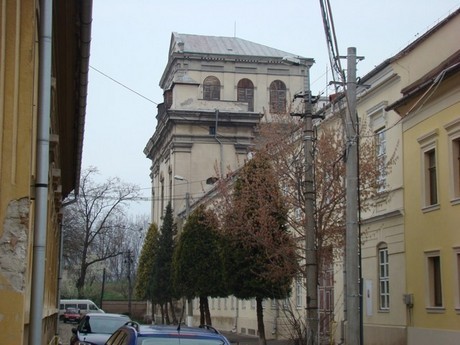Batthyaneum Library
In 1780, Ignac Batthyany, bishop of Transylvania, transformed a former Unitarian church into one of the most famous libraries in Transylvania. The Batthyaneum library is known all over the world for its rare manuscripts - over 60,000 documents, including the Codex Aureus (9th century), also known as the Lorsch Gospel, containing the Gospel of Mark and Matthew, David's Psalms, Codex Burgundus (15th century), Biblia Sacra (13th century) the Pentateuch from Orăştie (1850), Şerban Cantacuzino's Bible, and the New Testament from Balgrad (1648). The first astronomical observatory in Transylvania was founded here in 1792.
The Codex Aureus of Lorsch or Lorsch Gospels (Biblioteca Apostolica Vaticana, Pal. lat. 50, and Alba Iulia, Biblioteca Documenta Batthyaneum, s.n.) is an illuminated Gospel Book written between 778 and 820, roughly coinciding with the period of Charlemagne's rule over the Frankish Empire.
It was first recorded in Lorsch Abbey (Germany), for which it was presumably written, and where it was mentioned as Evangelium scriptum cum auro pictum habens tabulas eburneas in the catalogue of the Abbey's library, compiled in 830 under Abbot Adelung. Considering gold letters in the manuscript and its location at Lorsch, it was named the Codex Aureus Laurensius. In the tenth and eleventh centuries, the library of Lorsch was one of the best libraries of the world.
In the 16th century the manuscript was taken to Heidelberg (Otto Heinrich removed the contents of the library to Heidelberg, creating the famous Bibliotheca Palatina, just prior to Lorsch's dissolution in 1563), from whence it was stolen in 1622 during the Thirty Years' War; in order to be easy to sell, the codex was broken in two and the covers torn off. The richly illustrated first half reached the Migazzi Library and after that was sold to Bishop Ignac Batthany. This section is now in Alba Iulia, Romania, and belongs to Batthyaneum Library. The second half is in the Vatican Library. The front cover, with famous ivory reliefs in a classicising style of Christ treading on the beasts and archangels, is in the Vatican Museums, and the back cover, with the Virgin and Child with saints, angels and a Nativity of Christ below, is in the Victoria and Albert Museum in London.
The Codex Burgundus is a 15th century Flemish illuminated manuscript book of hours, in the Batthyaneum library in Alba Julia, Romania. It measures 180 x 120 mm (page), text 110 x 70 mm, binding 190 x 130 mm; and is written in one column with 16 lines per page. It has 55 miniatures on gold mosaic.
This is an anthology of prayers meant for the layman. It is written in Latin and French on quarto vellum and is bound in dark brown leather. The writing is uncial Gothic. The ornaments are geometrical and floral in blue, red, green, and gold. It has an iconographically unusual illustration of the Virgin Mary leading Joseph on a donkey.
The Codex Aureus of Lorsch, also known as the Lorsch Gospels, is one of the masterpieces of manuscript illumination produced during the period of Charlemagne's rule over the Frankish Empire.
"It was located for the first time in Lorsch Abbey (Germany), where it was mentioned as Evangelium scriptum cum auro pictum habens tabulas eburneas in the catalogue of the Abbey's library, compiled in 830 under Abbot Adelung. Considering gold letters in the manuscript and its location at Lorsch it was named the Codex Aureus Laurensius. In the tenth and eleventh centuries, the library of Lorsch was the one of the best libraries of the world."
Just prior to Lorsch's dissolution in 1563 the manuscript was taken to Heidelberg and incorporated into the Bibliotheca Palatina, from which it was stolen in 1622 during the Thirty Years' War.
". . . the codex was broken in two and the covers torn off. The richly illustrated first half reached the Migazzi Library and after that was sold to Bishop Ignac Batthyani. This section is now in Alba Iulia, Romania, and belongs to Batthyaneum Library. The second half is in the Vatican Library. The front cover is held by the Victoria and Albert Museum in London, and the back cover by the Vatican Museums of Rome".



